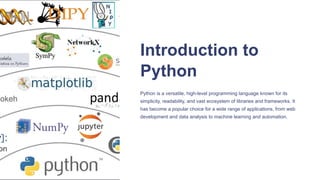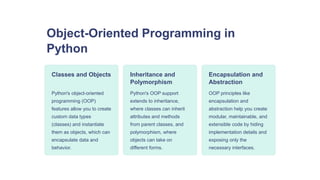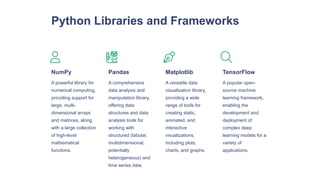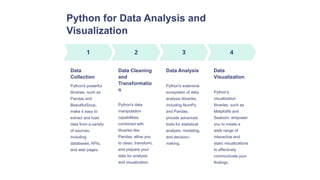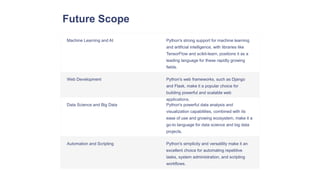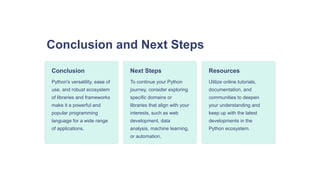overview of python programming language.pptx
- 1. Introduction to Python Python is a versatile, high-level programming language known for its simplicity, readability, and vast ecosystem of libraries and frameworks. It has become a popular choice for a wide range of applications, from web development and data analysis to machine learning and automation.
- 2. Python Syntax and Basic Data Types Syntax Python's syntax is designed to be easy to read and write, with a focus on code readability. It uses whitespace indentation to define code blocks, making it a more intuitive language to learn. Data Types Python supports a variety of built-in data types, including integers, floating-point numbers, strings, booleans, and more. These data types form the foundation for more complex data structures, such as lists and dictionaries. Variables Python variables are dynamically typed, allowing for easy and flexible manipulation of data. Variables can hold values of different data types, and their values can be easily changed throughout the code.
- 3. Control Structures and Conditional Statements 1 If-Else Statements Python's if-else statements allow you to make decisions based on certain conditions, enabling your program to take different actions based on the input or state of the program. 2 Loops Python's for and while loops allow you to repeatedly execute a block of code, making it easy to automate repetitive tasks and process collections of data. 3 Conditional Expressions Python's concise conditional expressions, known as "ternary operators," provide a compact way to write simple if-else statements in a single line of code.
- 4. Functions and Modules 1 Functions Functions in Python allow you to encapsulate and reuse blocks of code, making your programs more modular, maintainable, and efficient. 2 Parameters and Return Values Functions can accept input parameters and return values, enabling you to create powerful, flexible, and customizable functions to solve a wide range of problems. 3 Modules and Packages Python's extensive standard library and third-party packages (modules) provide a wealth of pre-built functionality, allowing you to leverage existing solutions and focus on building your application.
- 5. Object-Oriented Programming in Python Classes and Objects Python's object-oriented programming (OOP) features allow you to create custom data types (classes) and instantiate them as objects, which can encapsulate data and behavior. Inheritance and Polymorphism Python's OOP support extends to inheritance, where classes can inherit attributes and methods from parent classes, and polymorphism, where objects can take on different forms. Encapsulation and Abstraction OOP principles like encapsulation and abstraction help you create modular, maintainable, and extensible code by hiding implementation details and exposing only the necessary interfaces.
- 6. Python Libraries and Frameworks NumPy A powerful library for numerical computing, providing support for large, multi- dimensional arrays and matrices, along with a large collection of high-level mathematical functions. Pandas A comprehensive data analysis and manipulation library, offering data structures and data analysis tools for working with structured (tabular, multidimensional, potentially heterogeneous) and time series data. Matplotlib A versatile data visualization library, providing a wide range of tools for creating static, animated, and interactive visualizations, including plots, charts, and graphs. TensorFlow A popular open- source machine learning framework, enabling the development and deployment of complex deep learning models for a variety of applications.
- 7. Python for Data Analysis and Visualization Data Collection Python's powerful libraries, such as Pandas and BeautifulSoup, make it easy to extract and load data from a variety of sources, including databases, APIs, and web pages. Data Cleaning and Transformatio n Python's data manipulation capabilities, combined with libraries like Pandas, allow you to clean, transform, and prepare your data for analysis and visualization. Data Analysis Python's extensive ecosystem of data analysis libraries, including NumPy and Pandas, provide advanced tools for statistical analysis, modeling, and decision- making. Data Visualization Python's visualization libraries, such as Matplotlib and Seaborn, empower you to create a wide range of interactive and static visualizations to effectively communicate your findings.
- 8. Future Scope Machine Learning and AI Python's strong support for machine learning and artificial intelligence, with libraries like TensorFlow and scikit-learn, positions it as a leading language for these rapidly growing fields. Web Development Python's web frameworks, such as Django and Flask, make it a popular choice for building powerful and scalable web applications. Data Science and Big Data Python's powerful data analysis and visualization capabilities, combined with its ease of use and growing ecosystem, make it a go-to language for data science and big data projects. Automation and Scripting Python's simplicity and versatility make it an excellent choice for automating repetitive tasks, system administration, and scripting workflows.
- 9. Conclusion and Next Steps Conclusion Python's versatility, ease of use, and robust ecosystem of libraries and frameworks make it a powerful and popular programming language for a wide range of applications. Next Steps To continue your Python journey, consider exploring specific domains or libraries that align with your interests, such as web development, data analysis, machine learning, or automation. Resources Utilize online tutorials, documentation, and communities to deepen your understanding and keep up with the latest developments in the Python ecosystem.
